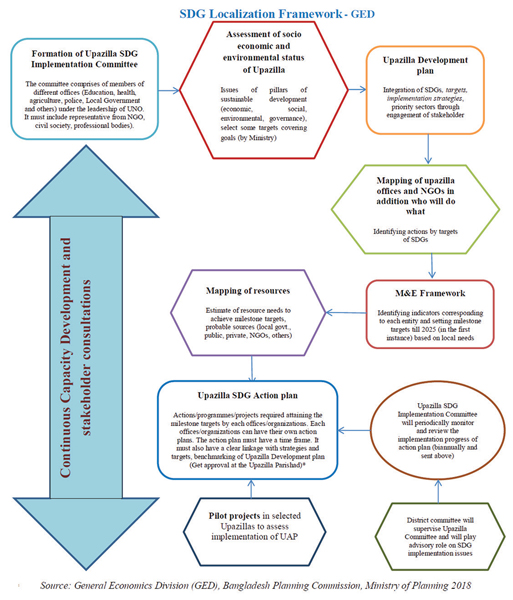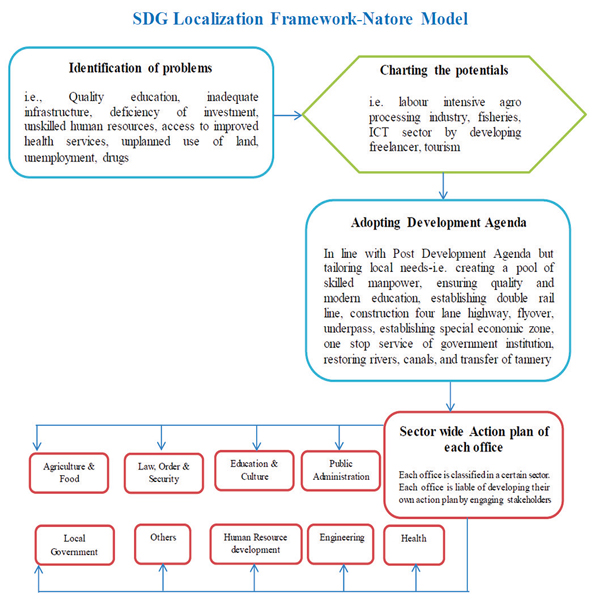Shamsul Alam | October 04, 2018
Successful implementation of SDGs in Bangladesh will largely hinge on how effectively it is integrated into national planning as well as localisation at district and upazila levels. At national level SDGs are fully integrated into the national development plan and strategies. The implementation at macro level is in full swing with supportive policy and enabling environment, towards designing national action plan. All these steps and measures are, however, not sufficient condition to materialise what SDGs are meant for; that is inclusiveness to leave no one behind and reach the furthest behind. To this end, General Economics Division (GED) of the Government of Bangladesh has put forward proposal for a framework for localisation and this was discussed in the SDGs Implementation and Review Committee. Decision was taken that at Upazila level UNO would coordinate implementation of this schematic localisation model involving government agencies and local government bodies. The purpose is to leverage coordination among multiple stakeholders while ensuring distributional efficiency in public resources by SDG targets. It also aims to maximise investment of multiple stakeholders, minimise vulnerabilities by keeping the marginalised on the Agenda and unlocking the potential for human development. Apart from this, the underlying agenda of localisation is to continuously focus on capacity development and resource mobilisation and utilisation at local level.
 The framework proposed by GED is for implementing at local administrative unit– Upazila and this model can be replicated at district levels coordinated by the Deputy Commissioners. Natore district administration by this time has put into practice this localisation model at district level chalking out action programme for all government agencies of Natore district. We have had the experience of implementing Millennium Development Goals pilot projects based on localisation framework at Upazila level and those experiences can be replicated and extended in attaining the SDGs
The framework proposed by GED is for implementing at local administrative unit– Upazila and this model can be replicated at district levels coordinated by the Deputy Commissioners. Natore district administration by this time has put into practice this localisation model at district level chalking out action programme for all government agencies of Natore district. We have had the experience of implementing Millennium Development Goals pilot projects based on localisation framework at Upazila level and those experiences can be replicated and extended in attaining the SDGs
Focused areas of activities in the action plan of the framework proposed by GED include, but is not limited to, earthwork, maintenance work, canal digging, cleaning, garbage disposal, gardening, tree plantation, sanitation, safe water supply, school feeding, adult education, sports-cultural activities, stopping child marriage, vaccination, supporting alternative dispute resolution (ADR), strengthening village defense, facilitating rainwater harvesting, re-excavating ponds, encouraging solar home system, skill training activities.
 Other Ministries/Divisions particularly Local Government Division (LGD) are taking steps for localisation. LGD is the biggest implementing Division in terms of allocation of development budget to be spent in rural areas. The framework proposed by GED which has been reflected in the Natore Model.
Other Ministries/Divisions particularly Local Government Division (LGD) are taking steps for localisation. LGD is the biggest implementing Division in terms of allocation of development budget to be spent in rural areas. The framework proposed by GED which has been reflected in the Natore Model.
(See SDG Localisation Framework – GED and SDG Localisation Framework – Natore Model.)
INCLUSIVENESS: As part of systematic follow-up and review of implementation of the agenda, the government for the first time organised a national conference that we call SDGs Implementation Review (SIR) from 4-6 July 2018. The conference brought together the representatives of the government including ministers and senior officials, NGOs, civil society organisations (CSOs), development partners, academia. Ministries, development partners and NGOs presented their implementation progress, identified challenges and charted future course of actions according to the matrix provided to them. The number of participants reached around 2000 in the three-day conference.
 In recognition of the fact that SDGs are overarching, the government has adopted a “whole of society” approach for implementation and attainment of the SDGs. As part of this, consultations were held on stakeholders’ engagement on the SDGs implementation involving the Parliamentarians, NGOs, CSOs, business community, development partners, ethnic minorities, professional groups, labour associations, and the media.
In recognition of the fact that SDGs are overarching, the government has adopted a “whole of society” approach for implementation and attainment of the SDGs. As part of this, consultations were held on stakeholders’ engagement on the SDGs implementation involving the Parliamentarians, NGOs, CSOs, business community, development partners, ethnic minorities, professional groups, labour associations, and the media.
INVESTMENT FOR IMPACT: SDGs are a reminder of the challenges the world faces to this date, as many countries were not able to make sufficient progress on every single goal under the MDGs. It is noteworthy that out of 169 targets, 41 targets are directly linked to international cooperation among nations and organisations.
With the aim to assess the cost of implementation of SDGs, Bangladesh has done an estimate to determine the financing needs for SDGs implementation. The “SDG Financing Strategy: Bangladesh Perspective” provides a well-defined work plan that highlights all the actions necessary to attain significant progress in the SDGs in Bangladesh. This report provides an estimate of the annual resource gap and an opportunity to revise government interventions and financing strategies accordingly.
The report estimates that an additional amount, over the current provision of investment related to SDGs by public sectors and external sources, would be USD 928.48 billion at 2015-16 constant prices. This amount would be required for SDGs implementation over the period of FY 2017-FY 2030, which is 19.75 per cent of the accumulated GDP. The annual average cost of SDGs would be USD 66.32 billion (at constant prices) for this period. (See Table: Financing Strategy for Implementation of SDGs)
Five potential sources of financing have been suggested in the report. These are: private sector financing, public sector financing, Public-Private Partnership (PPP), external financing of which foreign direct investment and foreign aid and grants and finally Non-Government Organisations (NGO). The external source has an average share of around 15 per cent. On average, public sector would account for around 34 per cent of the financing requirement, whereas private sector has the share of around 42 per cent during 2017-30 period. The average share of PPP is 6 per cent. The external sources have an average share of around 15 per cent where the share of FDI is 10 per cent and that of foreign aid is 5 per cent. Finally, the NGOs would contribute around 4 per cent for the same period.
For, SDG1, SDG2, SDG3, SDG4, SDG14, SDG16 and SDG17, public sector has the major responsibility. On the other hand, for SDGs (5, 7, 8, 9, 10 and 11), private sector has the major role. There are few SDGs, i.e., SDG (7, 8, 9,11 and 12) where Public Private Partnership is an option. Furthermore, external sources can play important role in SDG3, SDG6, SDG (7, 8, 9), SDG13, SDG14, SDG15, SDG16 and SDG17.
In fine, for inclusive attainment of the SDGs, participation of all stakeholders is a must. Coordination among ministries and government agencies can only ensure attainment of SDG targets at the grass-roots level.
Dr Shamsul Alam is Member (Senior Secretary), General Economics Division, Bangladesh Planning Commission.
The article was first published in the Financial Express, Bangladesh on 4 October 2018
